Teaching a child to ride a bike is an important and often challenging milestone in their development ,fostering confidence, independence, and a love for outdoor activities. In this comprehensive guide, we’ll explore how to introduce kids to the joys of cycling, from selecting the right bike to ensuring their safety on the road.
When and How to Introduce Kids to Bike Riding
The best age for a child to learn cycling depends on their individual capabilities.Create a safe environment for learning and provide support and encouragement.
Teaching a child to ride a bike is a rewarding journey, providing numerous physical and developmental benefits. By following these steps and prioritizing safety, you can guide your child toward a lifetime of cycling enjoyment, fostering confidence, health, and independence.
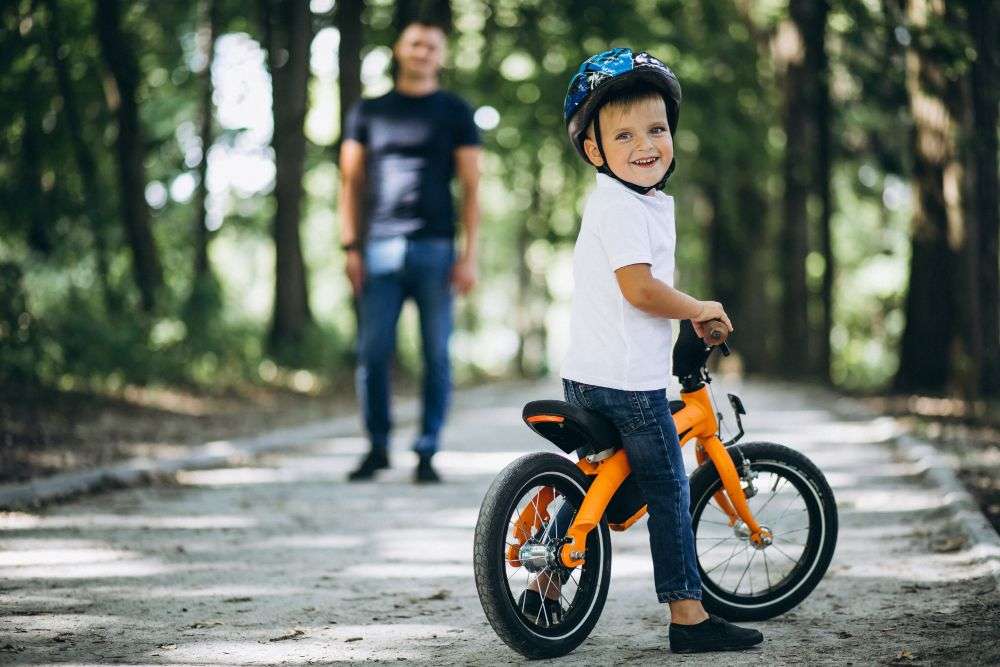
- Create a Positive Atmosphere:
Approach bike riding as an exciting adventure rather than a daunting task. Use positive language and expressions to convey your enthusiasm and belief in your child’s abilities.
- Set Realistic Expectations:
Celebrate small milestones and progress, even if it’s just balancing for a few seconds.
- Praise Effort, Not Just Results:
Encourage your child by acknowledging their effort, determination, and willingness to learn. Praise them for trying, even if they haven’t mastered the skill yet.
- Offer a Helping Hand:
Hold the back of the bike or use a push bar to offer physical support, especially in the early stages. Knowing you’re there for assistance can boost your child’s confidence.
- Use Positive Reinforcement:
Offer small rewards or incentives as a way to motivate your child. It can be something as simple as a special treat or extra playtime after a successful practice session.
- Create a Safe Learning Environment:
Choose a safe and quiet place for practice. A calm environment with minimal distractions and obstacles will help your child focus on learning without fear of accidents.
- Be Empathetic and Understanding:
Acknowledge your child’s fears or frustrations. Let them know it’s okay to feel this way and reassure them that it’s a normal part of the learning process.
- Involve Siblings or Friends:
If possible, involve older siblings or friends who can serve as role models. Riding with someone else can make the experience more enjoyable and less intimidating.
- Demonstrate Patience:
Be patient and understanding when your child makes mistakes or falls. Avoid expressing frustration or disappointment, as this can be discouraging.
- Celebrate Successes :
These celebrations can provide a sense of accomplishment and motivation to keep going.
How to choose the bike size for your kids ?
Selecting an appropriate bike for your child is a crucial first step in teaching them to ride and ensuring their safety and enjoyment. The right fit is essential as it directly impacts your child’s comfort, confidence, and ability to learn. When choosing a bike, consider the child’s height and age. Bikes come in various sizes, such as 12-inch, 14-inch, 16-inch, and 18-inch, with size charts available to help you make the right choice.
Here’s how to choose the perfect bike based on your child’s age, size, and skill level:
Consider Your Child’s Age:
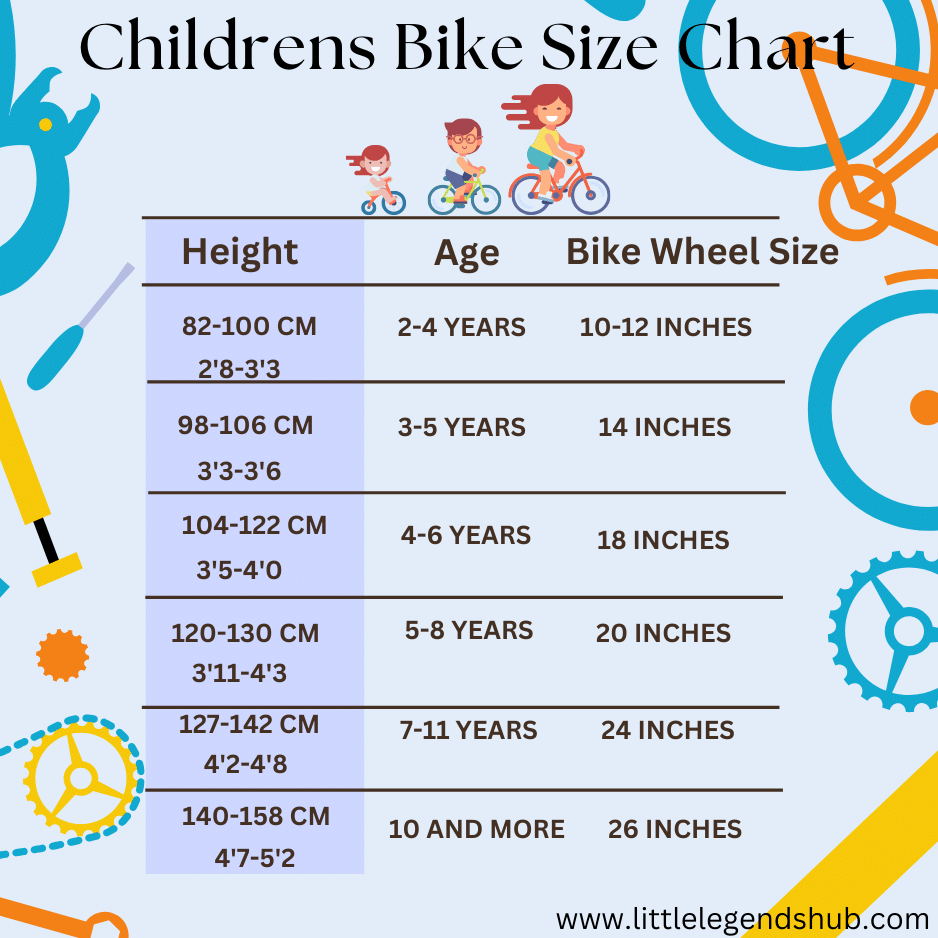
Age is a significant factor in determining the appropriate bike size. Kids of different ages have varying levels of physical development and motor skills. Here’s a general guideline:
2-4 years old: Most children in this age range are ready for a balance bike or a small pedal bike with 10-inch or 12-inch wheels.
3-5 years old: Most children in this age range are ready for a 14-inch or 16-inch bikes
4-6 years old: As they grow and gain more confidence, you can consider 18-inch bikes.
6-8 years old: Kids in this age group can often handle 20-inch bikes.
7 -11 years old: As they get older and more skilled, they can transition to larger bikes with 24-inch wheels and beyond.
10 years and up: Kids in this age group can often handle larger bikes with 26-inch wheel.
Measure Your Child’s Height:
Height is an important indicator of which bike size is suitable. Measure your child’s height with them standing flat-footed, and then compare it to the manufacturer’s guidelines for the bike’s size. Look for bikes that provide a comfortable, upright riding position with the feet flat on the ground. A proper fit allows your child to maintain control and balance.
Consider Skill Level:
A child’s previous experience with cycling should also influence your decision. If your child is a beginner, a balance bike can be a great choice. Balance bikes help kids develop balance and coordination before transitioning to a pedal bike. If they’ve already had some cycling experience, choose a pedal bike that aligns with their skill level. Make sure the bike has brakes and gears suitable for their capabilities.
Test Ride and Adjust:
If possible, let your child test ride the bike before purchase. They should be able to reach the handlebars comfortably and have a slight bend in their knees when sitting on the saddle. Adjust the seat and handlebar height to ensure the best fit. A proper fit encourages better control and stability, which is crucial for their confidence and safety.
Starting with Balance Bikes
Balance bikes are an excellent introduction to cycling, particularly for younger children. They allow kids to learn balance and steering before tackling pedaling. Balance bikes are often used for toddlers and infants, making them a fantastic choice for building confidence and coordination.
Balance bikes, often referred to as “run bikes” or “strider bikes,” are excellent tools for building the foundational skills required for cycling.Here’s why they’re so effective and how to use them:
Why Choose a Balance Bike:
- No Pedals: Balance bikes do not have pedals, allowing kids to focus solely on balance and steering. This simplifies the learning process.
- Confidence Building: Riding a balance bike teaches kids to balance on two wheels from an early age. This early exposure increases their confidence and makes the transition to a traditional pedal bike smoother.
- Safe and Gradual: Since their feet are always in contact with the ground, children feel safe and in control. They can easily stop or regain balance when needed.
Using a Balance Bike:
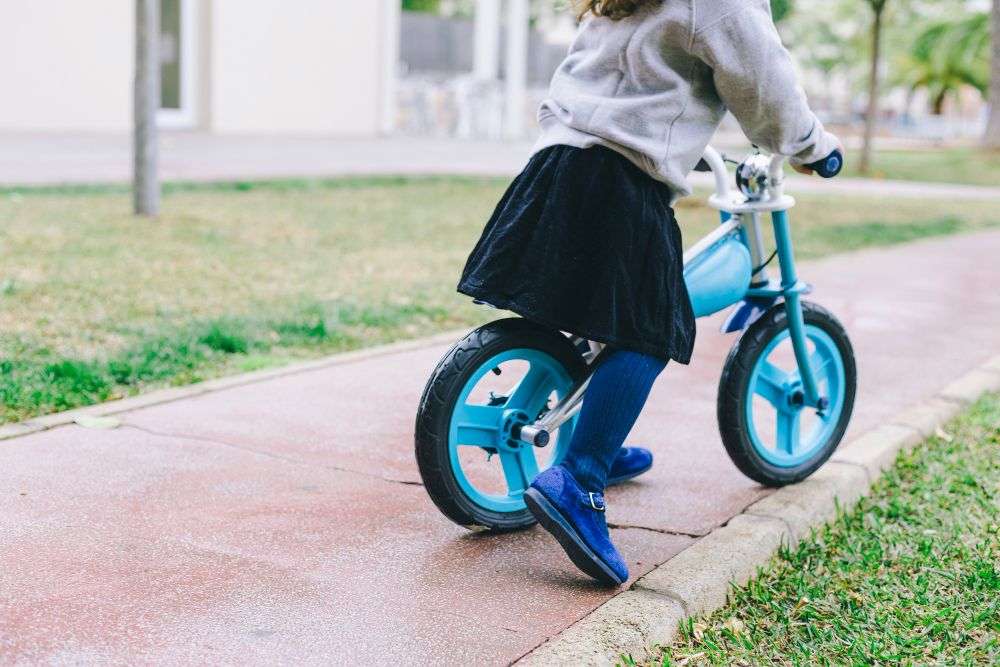
- Select the Right Size: Choose a balance bike that suits your child’s height. Their feet should comfortably touch the ground while sitting on the saddle.
- Encourage Striding: Show your child how to walk and run while straddling the balance bike. The idea is for them to learn how to balance and glide with both feet off the ground.
- Safety Gear: Ensure your child wears a properly fitting helmet and, if desired, knee and elbow pads for added protection.
- Practice and Play: Let your child practice on flat, smooth surfaces like driveways or empty parking lots. Encourage them to play games, such as gliding contests or obstacle courses, to make the learning process fun.
- Gradual Transition: Once your child has mastered balance and gliding, it’s time to transition to a pedal bike. This is typically a smoother process because they’ve already learned the most challenging aspect of cycling – balancing.
Benefits of a Balance Bike:
- Early Balance Skills: Balance bikes teach children to balance from a young age, a skill that is crucial for cycling and other activities.
- Confidence Building: Kids feel more confident about riding a bike when they start with a balance bike.
- Safety: The constant contact with the ground allows kids to control their speed and balance, reducing the risk of falls.
- Smooth Transition: The transition from a balance bike to a traditional bike is often seamless, as kids have already mastered the balance aspect.
Balance bikes are designed to help children build confidence, balance, and coordination, laying a strong foundation for their cycling journey.
Teaching Kids to Ride a Bike
Now, let’s dive into the process of teaching kids to ride a bike. What is the best way to teach a child to ride a bike? Start with these simple steps:
Balance and Coordination
- Encourage your child to practice balancing on their bike without pedals. This helps build their confidence and control.
- Begin by having your child sit on their bike with both feet flat on the ground.
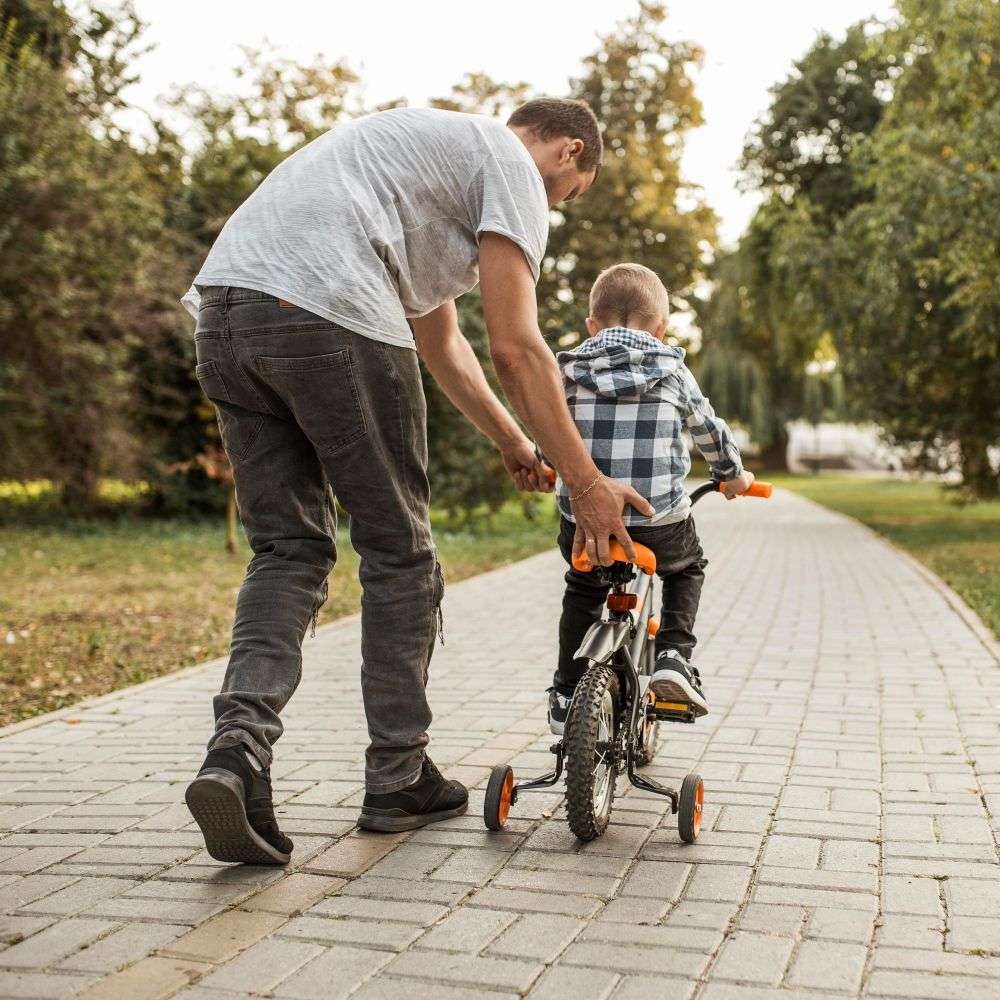
- Encourage them to walk the bike, using their feet to push themselves forward. This helps them get a feel for the bike’s balance.
- Gradually transition to striding, where your child lifts their feet off the ground for short distances while maintaining balance. Be patient, as this might take some time.
- Teach them to steer by leaning and turning the handlebars while striding. This helps them understand how the bike responds to their movements.
Coasting
- Once they’re comfortable balancing, have them practice coasting – lifting their feet and gliding. Once your child is comfortable striding and balancing, encourage them to lift their feet and coast for short distances. Emphasize that they can use their feet to regain balance if needed.
- Choose a gentle slope or a slight decline to help your child experience the feeling of coasting. Ensure it’s a safe and open area, away from obstacles or traffic.
- Keep practice sessions fun and engaging. You can create games or challenges to make coasting more enjoyable, such as seeing how far they can coast without touching the ground.
Introduce Pedals
- When your child has mastered coasting and is confident with their balance, it’s time to introduce pedaling. You can attach pedals to the bike if it’s not already a pedal bike.
- Start by having your child pedal while you support them. Hold onto the back of the saddle or the bike’s handlebars to provide stability. As they pedal, they’ll learn to coordinate their pedaling with balance.
- Encourage your child to practice stopping and starting with the pedals. This helps them develop control over the bike.
- Slowly reduce your support as your child gains confidence. Let them practice on their own, and provide guidance and encouragement.
Tips for a Smooth Transition
- Be patient and understanding.
- Ensure your child is comfortable and confident at each stage before moving on.
- Use positive reinforcement and praise to boost your child’s self-esteem.
- Make learning to ride a bike a fun and enjoyable experience, full of games and rewards.
Bike Safety for Preschoolers
Safety comes first when you’re teaching a child to ride a bike.Teach your child the essential safety rules, including wearing a child’s cycle helmet, knee, and elbow pads. Address the best age for teaching bike safety, which is as early as possible.
1. Helmets:
Helmets are the single most crucial piece of safety equipment for any cyclist, including children. Make sure your child wears a well-fitted helmet every time they ride.
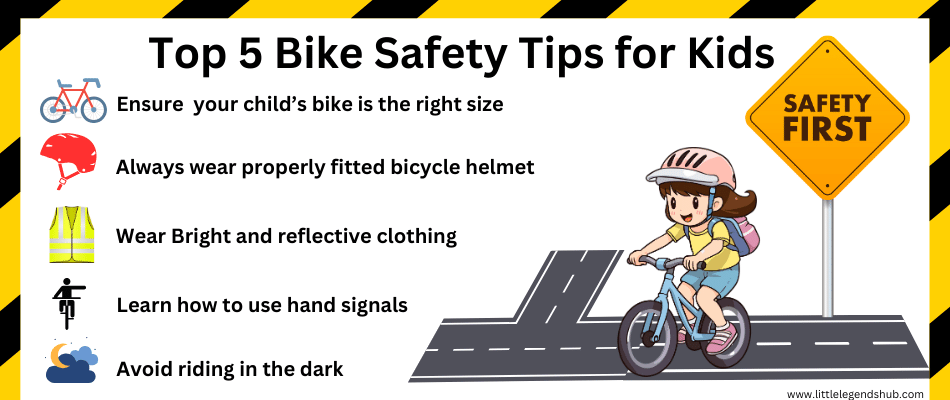
2. Knee and Elbow Pads:
Knee and elbow pads are crucial for protecting your child from injuries in case of falls. To ensure proper fit and use,choose pads that are the appropriate size for your child’s age and size.
3. Appropriate Clothing:
Proper clothing contributes to safety by ensuring your child is visible to others and protected from weather conditions. Bright and reflective clothing enhances visibility, especially if riding near traffic. Invest in fluorescent colors and reflective materials.
4. Teach the Importance of Safety:
It’s not enough to provide safety gear; you should also teach your child about its importance. Explain to them why wearing a helmet and pads is necessary for their well-being. Emphasize that these items are like a shield that helps prevent injuries.
5. Regularly Inspect and Replace Safety Gear:
Safety gear can wear out over time or become damaged after a fall. Regularly inspect helmets, knee and elbow pads, and clothing to ensure they are in good condition. If any gear looks worn out or broken, be sure to replace it. By properly fitting and using safety gear, you provide your child with the protection they need while riding a bike.
6. Lead by Example:
Set a positive example by wearing your own safety gear when cycling with your child. Children are more likely to embrace safety practices when they see adults doing the same.
Benefits of riding a bike for kids
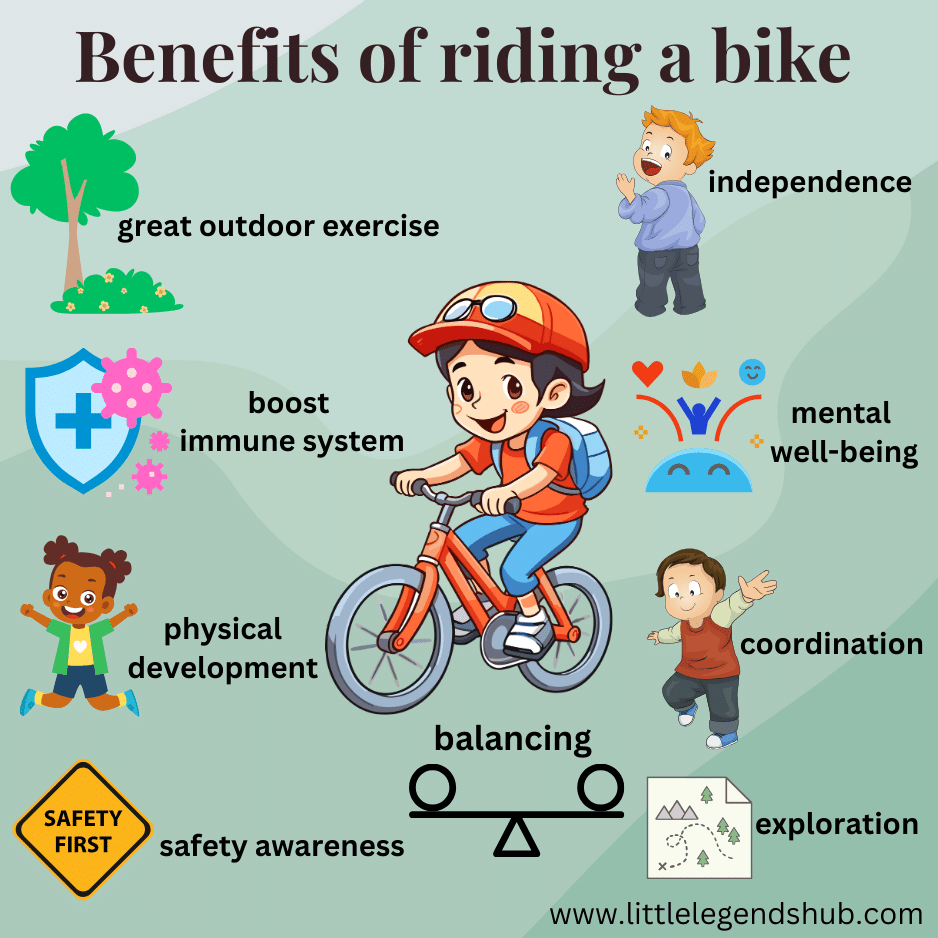
- Physical Activity: Biking is an enjoyable way for kids to stay active and healthy.
- Cardiovascular Health: It helps strengthen the heart and lungs.
- Balance and Coordination: Riding a bike improves motor skills and coordination.
- Muscle Development: It engages leg muscles and promotes growth.
- Independence: Kids gain confidence and independence while cycling.
- Mental Well-being: Cycling boosts mood and reduces stress.
- Environmental Awareness: Promotes eco-friendly transportation habits.
- Social Interaction: Allows for fun group activities with friends.
- Exploration: Kids can discover their surroundings and explore nature.
- Safety Awareness: Teaches road safety rules and awareness.
Remember that every child is unique, and their needs and preferences may differ. Pay attention to their cues and adapt your approach accordingly. By providing emotional support and encouragement, you can help your child build the confidence and motivation needed to become a skilled and passionate bike rider.
Cycling is more than just a skill; it’s a healthy activity. It’s a great outdoor exercise for kids, offering physical and mental benefits. Not only does it improve cardiovascular health, but it also enhances motor skills, fosters independence, and encourages a love for the outdoors.
